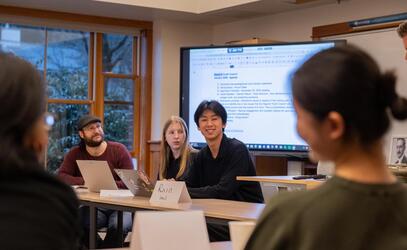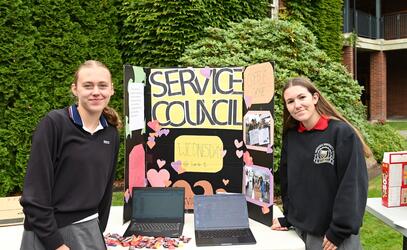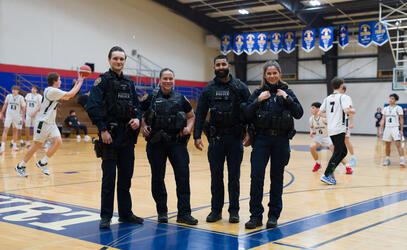This article originally appeared in the Winter 2018 issue of School Ties.
by Kyle Slavin
The new Sun Centre is at the heart of school life and community
Some of Cliff Sun’s (1972) strongest memories from his time as a boarding student at St. Michaels University School are of socializing with friends outside of class time. Because the school at that time lacked large, well-equipped spaces for students to hang out together during their off-time, students made the most out of whatever space they could find.
“We had common rooms, but they were rooms in the old School House building on the basement level that had a TV and a couch,” Cliff recalls. “They were small, but we would hang out in that confined space. A lot of the time, we would just hang out in the dormitory, using our bed as a table for card games or checkers.”
And while the campus has physically changed a lot since Cliff graduated in 1972, one thing remained the same – the school had no purpose-built space for both day and boarding students to gather when they weren’t in class. Over the last 20 years, students made the most of what spaces they could find, spending their recesses and lunch hours in The Snowden Library, the Monkman Athletic Complex foyer and the Crothall Centre’s hallways and classrooms.
The need for a designated student gathering space, as well as for a new dining hall, was officially identified nearly two decades ago. Former Head of School Bob Snowden, upon arriving in 1995, was tasked with undertaking a campus facilities master plan. He says three clear priorities were identified in the original master plan. One was seismic upgrading to buildings that needed it. Another priority was building teaching spaces for humanities and the arts. The third priority was facilities that would serve boarders well.
“Under that heading,” says Bob, “were things like athletic facilities that could be used by boarders – and a dining hall and student centre.”
Before the upgrades to School House began in the mid-2000s, Brown Hall was slated to be refurbished and a new student commons area was planned to be built below the existing dining hall and Tuck Shop. But as the school population increased over the years, Bob and architect Paul Merrick, who led the master plan development, realized that the school would inevitably outgrow the existing dining hall, which has served SMUS since 1957.
Over the last 16 years, SMUS has completed seismic upgrades, built new teaching spaces for humanities and the arts, and updated its athletic and boarding facilities. The main items that remained outstanding on the master plan were a new dining hall and a student centre.
The Sun Centre
On a warm, late-August evening, Cliff Sun walked through the quad toward the new Sun Centre, with a giant smile on his face. The businessman from Hong Kong was excited to see this new building, named in recognition of his generous financial contribution, finally completed and opening its doors to the school community.
Located between Schaffter Hall music building, the Christine Duke Theatre and the Science Block, the 27,730-square-foot Sun Centre is designed to meet the dining and social needs first identified in the school’s 2006 master plan. The building was completed just in time to welcome students back to campus for the start of the 2018–19 school year.
“The students’ time in the school is something they will always remember,” Cliff says, “and I hope the student commons will be something they really feel good about.”
On the main floor of the Sun Centre, you’ll find the student commons area. Furnished with couches, chairs, benches and tables, students have ample space to socialize during their downtime. Also located in the student commons is The Howard Café, where students can purchase coffee and snacks. Just off to the side are offices for boarding services and the school’s Personal and University Counsellors.
The building’s south side is adorned with stained glass. Here, a wide staircase climbs to the new dining hall with its welcoming high ceiling, large windows and floor-to-ceiling fireplace. Instead of the long benches that Brown Hall was furnished with, wooden chairs and tables make this a flexible space. A state-of-the-art kitchen for our catering staff help make cooking for (and cleaning up after) hundreds of people three times daily much easier.
More than 400 members of the community joined Head of School Mark Turner for the new building’s official grand opening on September 4. In a speech to the crowd from the second-storey balcony, Mark called the new building “iconic.”
“I chose the word ‘iconic’ for this building very carefully because if you go to the dictionary the word ‘iconic’ means that something will become symbolic,” he said. “I think that this building is already well on the way to being symbolic for SMUS. I think it is symbolic of the strength of our community. This is a place where our students and faculty will be sharing food together. The sharing of food and hospitality over millennia has been the way that different civilizations have reached out to their friends.”
Closely aligned with community, Mark added, the Sun Centre will “be a symbol of the connection between our day students and our boarding students.”
Fashion and Function
Designing a building like the Sun Centre proved to be a challenging project for Merrick Architecture.
“This site is one of the last remaining meaningful spaces on campus,” Paul Merrick says. “It was a site that, by its surroundings, was defined dimensionally. The question then became: ‘How can you fit those facilities in there?’” Separating the dining area from the common space and putting them on different storeys provided the solution.
“I think it’s a good combination of the need for physical capacity for function and the desire to pursue the opportunity to make a place of assembly that is more than just utilitarian,” he adds.
On the functional side, Paula Henchion, general manager for Sodexo at SMUS, says she appreciates having been brought into the conversation on day one of planning for the new kitchen and dining space.
“As the school grew, we did our best with minor modifications in Brown Hall to accommodate everyone and everything. But here we’ve had the opportunity to purpose-build a space to meet our needs as a school community,” she says. “We’re very excited to be in a beautiful, new space.”
Merrick Architecture has been involved in the school’s campus planning process for nearly 20 years. While each new building – and many of the old ones – maintain a similar style, each has its own unique characteristics. The Sun Centre is no different.
“SMUS has become a language of various brick applications because the original School House was built with brick. For the sake of consistency and integrity, brick became a building standard,” Paul says. “When designing the Sun Centre, we knew it wasn’t a place that needed to be about views or outlooks. It’s a place to meet others and exchange with those around you in intimate conversation.
Paul says the dining hall, especially, with its high ceiling, is inspired by Old World college dining halls that made use of natural light. It’s also inspired by the University of Toronto’s more recent Massey College and Hart House – also a social centre – with its Gothic Revival architecture.
The Sun Centre’s design translates those traditional influences into bright, clean, modern lines, with a decided nod to familiar West Coast architectural concepts. Walls of windows on the building’s west and south sides erase the visual boundary between the indoors and the outdoors. Clerestories lighten the dining hall’s central section. An open system of steel and wooden internal buttresses, beams and tensioned cables supports the vaulted wood-and-glass ceiling and roof – sure to give future architects and structural engineers among SMUS students food for thought as they eat their meals.
“It is very likely that when the dust settles a couple of decades from now, the Sun Centre will be seen as the halfway mark in facility redevelopment,” Bob Snowden said in an earlier edition of School Ties (Spring 2017). The school’s new strategic plan for 2020–2030 will likely identify additional projects and improvements to meet short- and long-term needs, including investments in facilities. All of these will compete for limited space on campus.
The Village Square
Even two decades ago, Paul and Bob were consciously planning for an anchor facility for the space the Sun Centre now occupies. Although not all the changes on campus that have been made since then have ended up located exactly where the original master plan placed them, Paul says, “One of the things that stuck was keeping School House as the centre of gravity on campus and then establishing a pedestrian backbone behind School House.”
“If you look at the way the buildings are now organized, there is, you could say, a village street that runs from the residences all the way to the door of Monkman Athletic Complex. That will become the main walkway – the main street through the village of our school,” Bob says. “The buildings that were in the Merrick master plan were deliberately designed with that in mind. To further that idea, we put the Sun Centre where it now is in order to complete that village street feel.”
Paul likens the Sun Centre to the village square. When designing the master plan and planning the centre, he wanted a space that promotes the gathering of the people in both a utilitarian and an attractive way. A dining hall and student commons were a perfect fit to make the vision real.
Mrs. Carole McMillan, Head of Personal Counselling, says that her team feels incredibly privileged to work in the new space. The counselling offices’ presence perfectly complements the building’s purpose.
“I love that our students now have some place to go that is ‘their’ building, that they see as a place where they belong, where they can make the space what they want it to be,” she says.
But Carole says that, even more than serving as a student space, the Sun Centre allows student services such as Personal and University Counselling to better integrate with and support the students.
“It’s amazing for us to be here, coupled with University Counselling, because we are where the students are, which increases their access to us,” she says. “I see our two departments merged together in this space almost as a student services model – where we are here and they are here, and together we can work to support them in all of their goals at SMUS. Being here allows us better access to the kids and makes us a more visible part of their life at the school.”
Community Helping Community
On that evening in August when we followed a beaming Cliff Sun across the quad, he, alongside Mark Turner and Paul Merrick, proudly cut the ribbon to open the doors to the Sun Centre. A small gathering of donors looked on, waiting to enter and tour the building they had helped fund.
The Sun Centre was made possible by the support of Cliff and many other donors and supporters in the SMUS community who shared a desire to give back. This new building – which is quickly becoming the heart of student life at SMUS – is both a testament to the SMUS community and a demonstration of the importance of philanthropy at the school.
“I feel the school has given me a golden opportunity,” Cliff says. “A lot of my current achievements and accomplishments are because of the opportunities I was able to grasp while at St. Michaels University School.” Born in Hong Kong, Cliff was brought up influenced by the Chinese philosopher Confucius. “Confucius believes in payback. When you receive something good, it’s only fair that you pay back in appreciation of the good that happened to you.”
Cliff’s donation to support the building now named for him is part of that payback – and part of paying his good fortune forward. “I owe it to the school for giving me such an opportunity to learn,” he says. “I’m a good man. I’m a kind-hearted person myself. That kind-heartedness comes through various influences, including SMUS.”
As the group of 70 donors congregated in the dining hall for its first official event, the goals of the Sun Centre were already being realized. People from across the school’s community – alumni, parents, students and staff – gathered to recognize the importance of that community.
As Bob Snowden says, “It’s important for human beings to have a sense of belonging. We all need to identify with the people that also belong to the community and feel part of that group. It creates a more supportive and interrelated community.” This new space – designated as a place where both the school’s boarding and day populations can mingle and socialize – does exactly that.
Bob sees the facility making more of an impact on boarding life than any other building that could have been constructed. Having a boarding program gives something very special to the school, and boarders need to be well-served, he says. “The ethos of the school is basically a boarding ethos where activities happen seven days a week and around the clock, and that benefits day students and boarders. All areas of the school need to function as important venues for boarders for the lives that they lead.”
Cliff can attest to that. He says that view is why he is proud to support a project that focuses on bringing together the entire SMUS community. He understands, through his own experiences here, that the time students spend socializing with each other and with other members of the school community will be some of the most cherished memories they take away from their years at SMUS.
“The students will be raised in that student commons,” he says. “Students of different ages, different grades and from different countries will spend their golden years being raised in this new building and they will make long-term friendships there. Their time at the school is something they hopefully treasure.”
Students at the school now have an attractive, usable area where they can build strong ties with each other for years to come.


